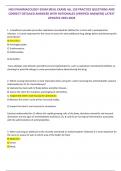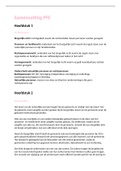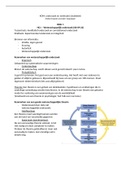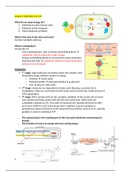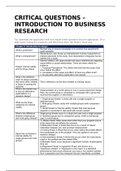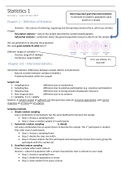Book summary
Tilburg University
,CHAPTER 3: How marketing communications work
3.1 Hierarchy-of-effects model
A hierarchy-of-effects model assumes that things have to happen in a certain order, implying that the
earlier effects from necessary conditions in order for the later effects to occur. According to these
models, consumers go through 3 different stages in responding to marketing communications:
1. Cognitive stage consumers engage in mental (thinking) processes which lead to awareness
and knowledge of the brand communicated.
2. Affective stage emotional and evaluative responses occur which are associated with the
advertised brand and attitudes towards the brand are formed.
3. Conative stage undertaking actions with respect to the advertised brand (buying).
Alternative models are developed as well:
Low-involvement hierarchy-of-effects model after frequent exposure to marketing
messages, consumers might buy the product, and decide afterwards how they feel about it.
(cognitive-conative-affective hierarchy)
Experiential hierarchy-of-effects model consumers’ affective responses towards a product
lead them to buy it and if necessary, they reflect on it later. (Affective-conative-cognitive
hierarchy)
In the Foote-Cone-Belding (FCB) grid
(integration of the different sequence
models) four different situations are
distinguished, based on the high-low
involvement and think-feel dimension.
Think-feel dimension: a continuum
reflecting the extent to which a decision
is made on a cognitive or affective basis.
Involvement: the importance people
attach to a product or buying decision,
the extent to which one has to think it
over and level of perceived risk associated with an inadequate brand choice.
An alternative is the Rossiter-Percy grid, which classifies four different situations, based on the
dimensions of high-low involvement and fulfilling a transformational or informational buying motive.
Transformational buying motive consists of positive motivations (sensory gratification, social
approval, intellectual stimulation), while informational buying motives refer to reducing or reversing
negative motivations (solving or avoiding a problem, normal depletion).
Top-of-mind awareness (TOMA) = indicates which brand is the most salient within a product
category. Brands that are top of mind are more likely to be purchased.
Attitude formation and change
An attitude is a person’s overall evaluation of an object, a product, a person, etc. Brand attitudes
liking/disliking a brand. Brand attitudes can be changed over time. An attitude consists of three
components:
1. Cognitive: knowledge, beliefs and evaluations of an object
, 2. Affective: the feelings associated with an object
3. Behavioral: action readiness with respect to the object
To change attitudes, marketers might concentrate on changing one of the three components.
Different communications models regarding attitude formation and attitude change can be classified
along two dimensions. The first refers to the way attitudes are formed – primarily cognitive,
affective or behavioural; the second is about the level of elaboration of a message, or central-route
versus peripheral-route processing. MOA
1. Motivation: a willingness to engage in behavior, make decisions, pay attention. Motivation is
to a large extent influenced by consumer needs in goals. Consumer needs can be categorized
in functional, symbolic (how we see ourselves and how we would like to be perceived by
others), or hedonic (consumers’ desires for sensory pleasure).
Needs/goals can also be classified as approach or promotion goals (positive outcomes), and
avoidance or prevention goals (avoiding negative outcomes).
In order to be persuasive, marketing communications should tap into consumers’
motivational concepts and marketers need to understand what goals consumers are trying to
accomplish by buying the product.
2. Ability: refers to the resources needed to achieve a particular goal.
3. Opportunity: the extent to which the situation enables a person to obtain the goal set.
If MOA is high, the elaboration likelihood is said to be high and consumers are expected to engage in
central-route processing. This means that they are willing to elaborate on the information.
Depending on the quality and credibility of the arguments, consumers will react by producing
counter-, support or neutral arguments, which induce a negative, positive or no attitude change,
respectively. Attitudes formed via the central route prove to be good predictors of later behaviour
and are fairly resistant to other persuasive messages.
, If one or more of the MOA factors are low, consumers are more likely to process the information
peripherally. result: no real information processing, but an evaluation based on simple, peripheral
cues.
The reason why consumers start paying more attention to peripheral cues is that in many ads
peripheral cues form the only processable information under circumstances of low motivation,
limited ability or limited opportunity.
There are six types of attitude formation and change.
High elaboration likelihood, cognitive attitude formation
Multiple Attributes Models (Expectancy-Value model, Fishbein Model)
In this model, brand attitudes are made up of three elements:
1. Relevant product attributes
2. The extent to which one believes the brand possesses these attributes
3. The evaluation of these attributes or how good/bad one thinks it
Brand attitude is represented by the sum of the products of brand beliefs and attribute evaluations:
The Theory of Reasoned Action (TORA) is an extension of the Expectancy– Value model. This model
provides a link between attitude and behavioral intention, which is determined also by subjective
norm. A subjective norm comprises the belief one holds regarding what different reference groups
consider as socially desirable behaviour, weighted by the consumer’s need or willingness to behave
according to the norms of the particular reference group.
The TORA has been further extended into the Theory of Planned Behaviour (TPB). This extension is
necessary to be able to deal with behaviors over which people have incomplete volitional control.
Behaviour also often depends on non-motivational factors, such as resources (lacking the money to
buy a Lamborghini). Perceived behavioral control is added to the TORA to build the TPB Perceived



